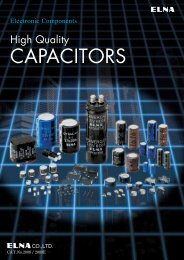Aluminum Electrolytic Capacitors
Aluminum Electrolytic Capacitors
Aluminum Electrolytic Capacitors
You also want an ePaper? Increase the reach of your titles
YUMPU automatically turns print PDFs into web optimized ePapers that Google loves.
TECHNICAL NOTEALUMINUM ELECTROLYTIC CAPACITORSWITH CONDUCTIVE POLYMER SOLID ELECTROLYTE®• During cleaning, control the cleaning solutionagainst contamination.6. Fixing adhesives and coating materials.• Do not use halogenated fixatives and coatings.• Before using a fixative or coating, remove fluxresidues and contaminants from between the PCBand the sealing section of capacitors.• Dry the cleaning solution before using the adhesiveor coating.• Do not cover up all the sealing sections (terminalside) of capacitors with the adhesive or coating.• Heat curing conditions of fixative and coating.Other Cautions1. Do not directly touch the terminals of solid conductivepolymer aluminum electrolytic capacitors.Failure to do so can cause electric shock or burns.Before use, allow capacitors to discharge through a1k resistor (with a sufficient margin to the heatgeneration capacity) as needed.2. Do not short-circuit between the terminals ofthe solid conductive polymer aluminum electrolyticcapacitors with electric conductor. Do not subjectcapacitors to conductive solutions such as acidand alkaline water solutions.3. Periodic inspection should be performed on thecapacitors for the industrial equipment application.Check the following checkpoints.• Visual inspection to check for significant defects.• Electrical performance: leakage current, ratedcapacitance, tangent of loss angle, ESR, and itemsspecified in the catalog or delivery specification.4. Be careful of the following cases of emergency.• In case of a short during use of capacitors in sets,producing gas, turn off the main power of the set orunplug the power cord from the outlet.• In case of a short, producing gas, it may take a fewseconds to a few minutes depending on theconditions. Therefore, ensure that the protective circuitof the power supply works during this time.• If the gas gets in your eyes, rinse them immediately.Gargle if the gas is inhaled.• Do not lick the electrolyte of capacitors. When theelectrolyte gets on your skin, wash it off with soapimmediately.• During delivery, capacitors are stored in airtightmoistureproof bags to ensure satisfactory soldering.Once the bag is opened right before mounting, it isbetter to use up the capacitors. If some are unavoidablyleft over, return them to the moistureproof bag,and seal the opening hermetically.• Solid conductive polymer aluminum electrolyticcapacitors may have increased leakage currentwhen unused or stored for a long time after mountedon equipment. This phenomenon often occurs athigh ambient temperatures; however, leakagecurrent will decrease through voltage treatment. Ifleakage current still increases after a lapse of morethan one year at ambient temperature (shorter timeat high temperatures), treat with voltage as needed.In design of equipment, consider the effect ofincrease in initial current, and install protectivecircuits as needed.Please check that recommended voltage treatmentconditions are provided for each series.• Do not store capacitors in an environment directlyexposed to water, saltwater spray, oil spill orcondensation.• Do not store capacitors in an environment filled withtoxic gas such as hydrogen sulfide, sulfurous acid,nitrous acid, chlorine, ammonia, etc.• Do not store capacitors in a place exposed to ozone,ultraviolet rays, or radiation.6. Please take the following actions whendisposing of solid conductive polymer aluminumelectrolytic capacitors.• Entrust to specialists of industrial waste treatment forincineration.7. Others• Before using capacitors, check the details of thisdelivery specification and catalog as well as thefollowing.Technical Report of Japan Electronics and InformationTechnology Industries AssociationEIAJ RCR-2367CGuideline of notabilia for fixed aluminum electrolyticcapacitors for use in electronic equipment5. Storage Conditions.• Do not store at high temperature and high humidity.Store at a temperature of 5 to 35°C and a relativehumidity of less than 75%, keeping free from directsunlight.CAT.No.2010/2011Ea






